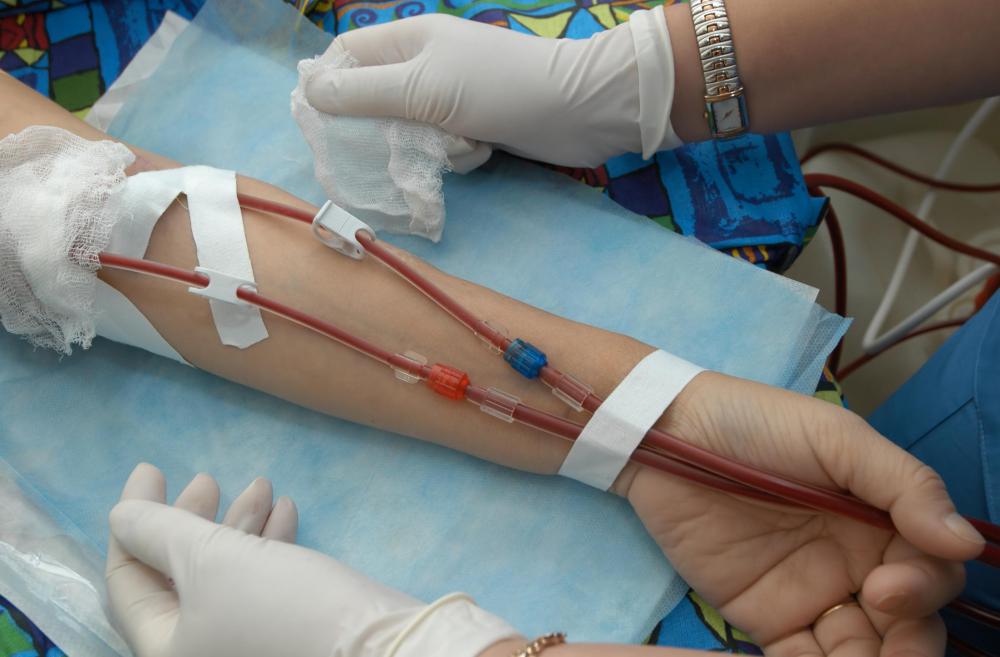At WiseGEEK, we're committed to delivering accurate, trustworthy information. Our expert-authored content is rigorously fact-checked and sourced from credible authorities. Discover how we uphold the highest standards in providing you with reliable knowledge.
What Factors Affect a Myelodysplastic Syndrome Prognosis?
The myelodysplastic syndromes (MDS) are a group of disorders involving abnormal myeloid stem cells. Myeloid stem cells are produced by bone marrow and develop into white blood cells (WBC), red blood cells (RBC) or platelets, and myeloid stem cell disorders are potentially life-threatening. Physicians principally use the International Prognostic Scoring System (IPSS) or the World Health Organization Prognostic Scoring System (WPSS) to determine myelodysplastic syndrome prognosis. Both of these systems use factors including percentage of bone marrow myoblasts, cytogenic abnormalities, number of cytopenias, sex and age to predict patients' possible outcomes. The activity of lactate dehydrogenase in blood serum and a patient's dependence on blood transfusions also may be useful for myelodysplastic syndrome prognosis.
Myelodysplastic syndromes can develop because of genetic factors, in people who have undergone chemotherapy or radiation treatments or have been exposed to toxins such as benzene, or for unknown reasons. MDS can cause cytopenias, or insufficient cell numbers, of WBCs, RBCs or platelets, or abnormalities in these cells. Patients also can develop iron overload. Certain types of MDS can progress into acute myeloid leukemia (AML), so MDS is sometimes called "preleukemia" or "smoldering leukemia." The accuracy of myelodysplastic syndrome prognosis is important in determining the best treatment for patients, as well as for classifying medical study participants.

Scientists at an MDS Risk Analysis Workshop developed the IPSS in 1997, and it since has become the most commonly used system for myelodysplastic syndrome prognosis. The IPSS divides MDS cases into categories depending on percentage of bone marrow myoblasts, cytogenic abnormalities and number of cytopenias. Doctors use these categories to determine myelodysplastic syndrome prognosis, which includes patients' expected overall survival and risk for developing leukemia.

Using IPSS criteria, MDS patients with too few red blood cells but normal levels of platelets and white blood cells suffer from refractory anemia (RA), and RA patients whose red blood cells also contain too much iron have refractory anemia with ringed sideroblasts (RARS). Refractory anemia with excess blasts (RAEB) refers to MDS with too few red blood cells and in which from 5 percent to 19 percent of blood cells in the bone marrow are blasts, or immature blood cells, along with possible white blood cell and platelet abnormalities. MDS patients with too few RBCs, WBCs and platelets, in whom blasts comprise from 20 percent to 30 percent of blood cells in the bone marrow and 5 percent or more in the blood, suffer from refractory anemia with excess blasts in transformation (RAEB-T). Refractory cytopenia with multilineage dysplasia (RCMD) means a patient has too few of more than one type of blood cell. Some cases of myodysplastic syndrome are associated with an isolated del(5q) chromosome abnormality, and unclassified MDS cases involve cytopenia of one type of blood cells and normal numbers of blasts.

The MDS Risk Analysis Workshop found that patients suffering from RARS are likely to survive the longest, followed by patients with RA. RAEB patients had a significantly lower lifespan than those with RARS or RA, and RAEB-T patients had the shortest expected survival; none of the RAEB-T patients in the analysis lived more than 5.5 years after being diagnosed with MDS. Myelodysplastic syndrome prognosis was more positive for female patients than for males, and patients over age 60 had decreased survival. RARS and RA patients had the smallest chance of developing AML, while RAEB patients had a significantly higher risk. All of the RAEB-T patients studied in the workshop developed AML within four years of their MDS diagnosis.

The WPSS divides RAEB into types one and two (RAEB-1 and RAEB-2) for purposes of myelodysplastic syndrome prognosis. From 5 percent to 9 percent of the blood cells in the bone marrow of patients with RAEB-1 are blasts and less than 5 percent in the blood are blasts. In patients with RAEB-2, from 10 percent to 19 percent of blood cells in the bone marrow and from 5 percent to 19 percent of blood cells in the blood are blasts. Patients with RAEB-1 have about a 25 percent risk of developing AML, while RAEB-2 patients have a 33 percent risk.

Following the development of the IPSS and WPSS, scientists identified more factors that affect leukemia risk and overall survival for MDS patients. Patients with MDS without excessive blasts and who are dependent on blood transfusions have a significantly higher leukemia risk and shorter overall survival than patients who do not need transfusions. Transfusion dependency also is a significant independent risk factor for patients with RARS and del(5q) MDS. MDS patients who have higher white blood cell levels at the time of MDS diagnosis tend to survive longer, and patients with high serum lactate dehydrogenase activity have a decreased overall survival. As of mid-2011, scientists continued efforts to refine myelodysplastic syndrome prognosis.
AS FEATURED ON:
AS FEATURED ON:
















Discussion Comments
What happens when you have MDS RARS but also suffer from genetic hemochromatosis? Double whammy I know, but what happens to your prognosis then?
Post your comments